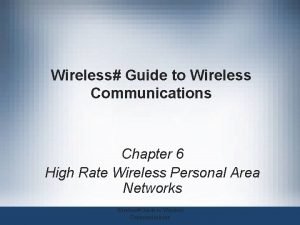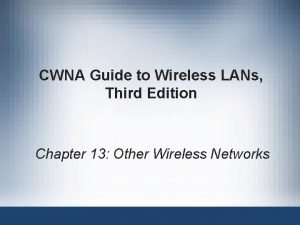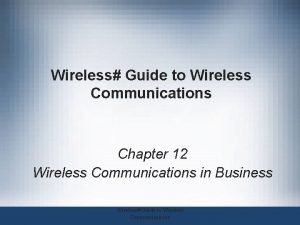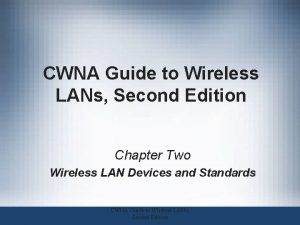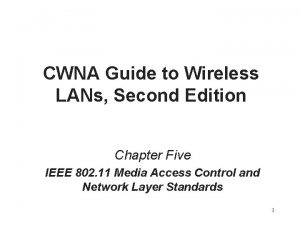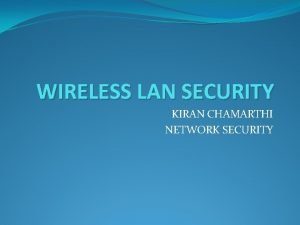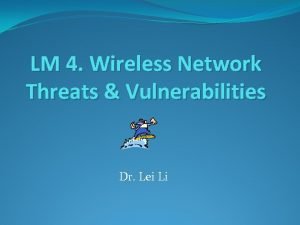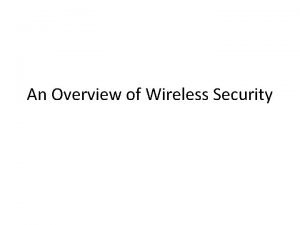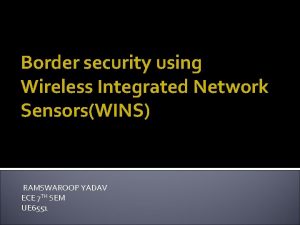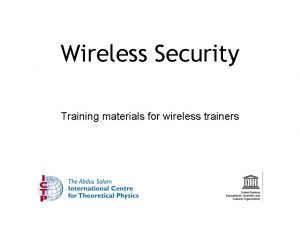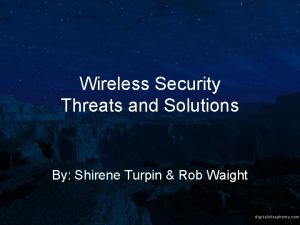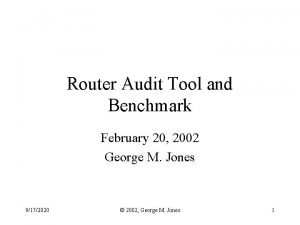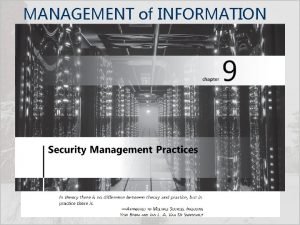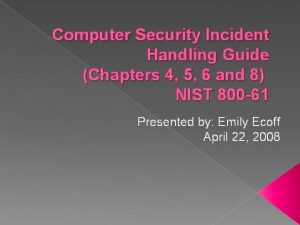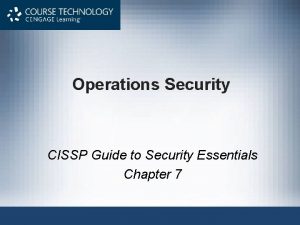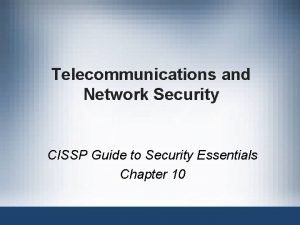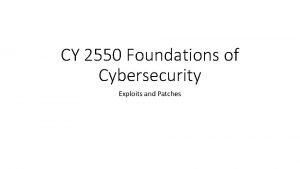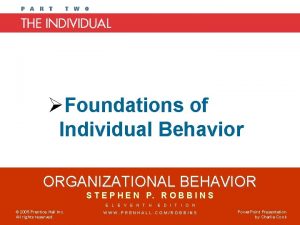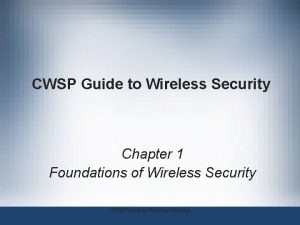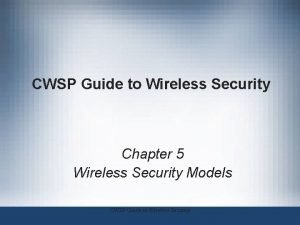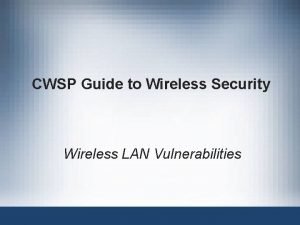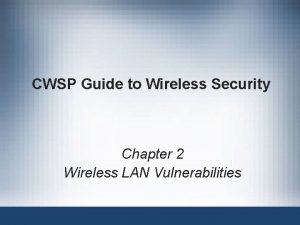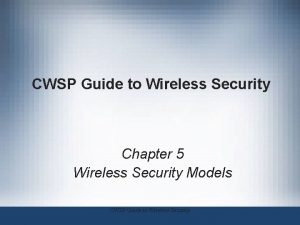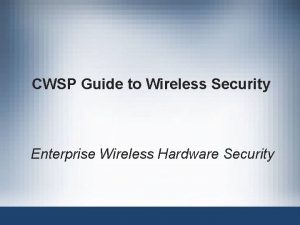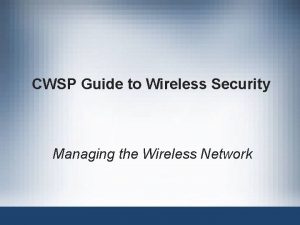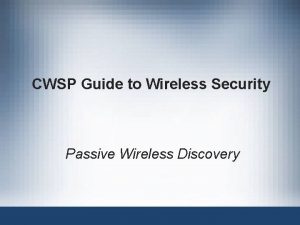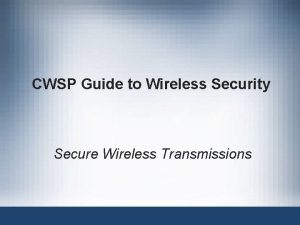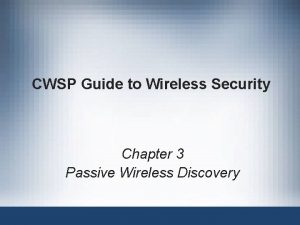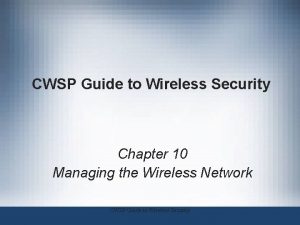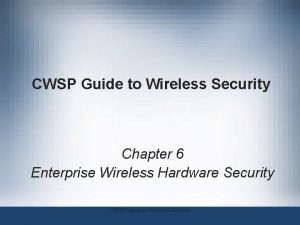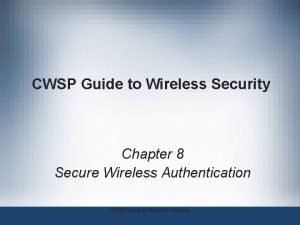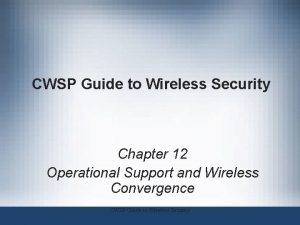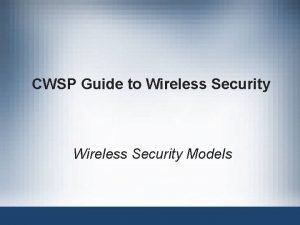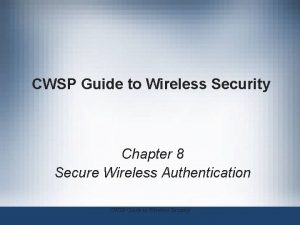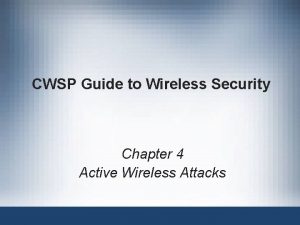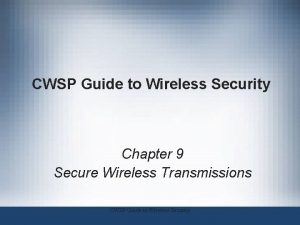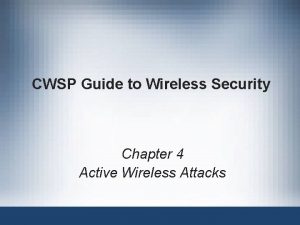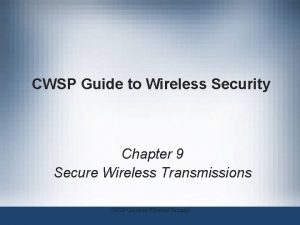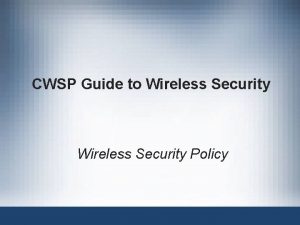CWSP Guide to Wireless Security Foundations of Wireless

















































- Slides: 49

CWSP Guide to Wireless Security Foundations of Wireless Security

Objectives • List the advantages and disadvantages of a wireless local area network • Describe the functions of the wireless LAN standards and regulatory agencies • List wireless networking and security certifications • Define information security and tell why it is important in wireless networks • List the five types of IEEE WLANs CWSP Guide to Wireless Security 2

Wireless in Our World • Wireless LAN applications – Can be found in every industry whose employees need or want to conduct business without being confined to a specific location CWSP Guide to Wireless Security 3

Business • “Flatter” organizations – Employees are involved in team meetings that occur away from their desks • Wireless technology – Has dramatically changed how and where business meetings take place • Has made the meetings more focused and productive • Wireless LANs benefits – Increased productivity, time/financial savings CWSP Guide to Wireless Security 4

Business (continued) • Voice over wireless LAN (Vo. WLAN) – Emerging wireless technology – Uses the existing data WLAN to make and receive telephone calls – Vo. WLAN devices can forward business calls to their mobile phones during regular business hours CWSP Guide to Wireless Security 5

Business (continued) CWSP Guide to Wireless Security 6

Travel • Travel industry is a leader in adopting wireless technologies – Most airports provide wireless access hotspots – Some airports use wireless technology to keep track of passenger luggage • Wireless PDAs now replace walkie-talkies • WLAN technology is used to communicate with the aircraft – Once it has parked or is taxiing on the ground • WLAN technologies are not restricted to airplanes CWSP Guide to Wireless Security 7

Education • WLANs are ideal for colleges and schools • Educational institutions were early users of WLANs • Wireless LAN connections offer teachers and students an important degree of freedom – Teachers create classroom presentations on laptops – Can access the school network wirelessly from almost any location • Most schools publish maps showing the location of wireless access points CWSP Guide to Wireless Security 8

Education (continued) CWSP Guide to Wireless Security 9

Education (continued) • WLAN technology translates into a cost savings for colleges as well – Classrooms become fully accessible computer labs – Colleges no longer have to consider the expense of adding multiple open computer labs – Wireless networks are also used to promote safety and security CWSP Guide to Wireless Security 10

Health Care • The health care industry has embraced wireless technology to improve patient care • Wireless LAN point-of-care computer systems – Allow medical staff to access and update patient records immediately – Verify that medication is being administered to the correct patient in the correct dosage CWSP Guide to Wireless Security 11

Wireless Advantages and Disadvantages • With any technology, there advantages and disadvantages to be considered – Wireless LANs are no exception CWSP Guide to Wireless Security 12

Advantages • Mobility – Primary advantage of wireless technology – Enables individuals to use a laptop computer that is always in contact with the network • Easier and less expensive installation – Installing network cabling can be expensive – Significant time required to install network cabling – Wireless technologies allow creation of an office in a space where the traditional infrastructure doesn’t exist CWSP Guide to Wireless Security 13

Advantages (continued) • Increased reliability – Wireless LAN technology eliminates cable failures and increases the overall reliability of the network • Disaster recovery – Hot site has all the equipment needed for an organization to continue running • Generally run by a commercial disaster recovery service – Cold site provides office space but the customer must provide and install the equipment – Many businesses use cold sites and WLANs as a major piece of their disaster recovery plan CWSP Guide to Wireless Security 14

Disadvantages • Radio frequency interference – Signals from other devices can disrupt wireless • Health risks – High levels of RF can produce biological damage through heating effects – It is not known if or to what extent lower levels of RF might cause adverse health effects • Security – Greatest disadvantage to wireless LANs – Attacks on wireless networks: denial-of-service, stealing passwords, altering messages CWSP Guide to Wireless Security 15

Information Security and Wireless LANs • Knowing how to defend a wireless network against a wide array of attacks – Begins with an understanding of what information security is CWSP Guide to Wireless Security 16

What is Information Security? • Information security – The tasks of guarding digital information – Ensures that protective measures are properly implemented – Cannot completely prevent attacks or guarantee that a system is totally secure – Intended to protect information • Characteristics of secure information – Confidentiality, integrity, and availability CWSP Guide to Wireless Security 17

What is Information Security? (continued) • Information security protects devices that store, manipulate, and transmit the information • Information security is achieved through a combination of three entities – Innermost layer consists of the products that provide the necessary security – Middle layer is people – Outmost layer consists of procedures CWSP Guide to Wireless Security 18

What is Information Security? (continued) CWSP Guide to Wireless Security 19

Difficulties in Defending against Attacks • Factors that make security increasingly difficult – – – Speed of attacks Sophistication of attacks Attackers now detect weaknesses faster Distributed attacks User confusion • Zero day attacks – Attacker discovers and exploits a previously unknown flaw CWSP Guide to Wireless Security 20

Why Wireless Security is Important • Unique challenges – – Unauthorized users can access the network Attackers can view transmitted data Employees can weaken installed security protections Attackers can easily crack existing wireless security • Attackers can: – Steal personal data – View wireless transmissions • With freely available wireless packet sniffer – Inject malware CWSP Guide to Wireless Security 21

Why Wireless Security is Important (continued) • Attackers can (continued): – – Download harmful content Cause loss of equipment Cause violation of an ISP agreement Identify “weak link” users CWSP Guide to Wireless Security 22

Why Wireless Security is Important (continued) CWSP Guide to Wireless Security 23

Wireless Standards Organizations and Regulatory Agencies • Three primary standard-setting and regulatory bodies – Institute of Electrical and Electronics Engineers (IEEE) – Wi-Fi Alliance – U. S. Federal Communications Commission (FCC) CWSP Guide to Wireless Security 24

Institute of Electrical and Electronics Engineers (IEEE) • IEEE – – – The most widely known and influential organization Dates back to 1884 Establishes standards for telecommunications World’s largest technical professional society Technical, educational, and professional activities Project 802 • Computer network architecture standards • Quickly expanded into several different categories of network technology CWSP Guide to Wireless Security 25

Institute of Electrical and Electronics Engineers (IEEE) (continued) CWSP Guide to Wireless Security 26

Institute of Electrical and Electronics Engineers (IEEE) (continued) CWSP Guide to Wireless Security 27

Institute of Electrical and Electronics Engineers (IEEE) (continued) CWSP Guide to Wireless Security 28

Wi-Fi Alliance • Wireless Ethernet Compatibility Alliance (WECA) – Consortium of wireless equipment manufacturers and software providers, formed in 1999 – Goals • To encourage wireless manufacturers to use the IEEE 802. 11 technologies • To promote and market these technologies • To test and certify that wireless products adhere to the IEEE 802. 11 standards – In October 2002, WECA changed its name to Wi-Fi (Wireless Fidelity) Alliance CWSP Guide to Wireless Security 29

Wi-Fi Alliance (continued) CWSP Guide to Wireless Security 30

Federal Communications Commission (FCC) • FCC – Controls and regulates wireless transmissions for use by citizens in the United States – Serves as the primary regulatory agency for wireless communications – Independent government agency that is directly responsible to Congress – Established by the Communications Act of 1934 – Process applications for licenses – Represents US in negotiations with other nations about telecommunications issues CWSP Guide to Wireless Security 31

Federal Communications Commission (FCC) (continued) • Radio frequency spectrum – Entire range of all radio frequencies – Divided into over 450 different sections or bands • License-exempt spectrum or unregulated bands – Available nationwide to all users, without a license – Devices can be either fixed or mobile – Devices can interfere with each other • Bands used for WLANs – Industrial, Scientific and Medical (ISM) – Unlicensed National Information Infrastructure (UNII) CWSP Guide to Wireless Security 32

Federal Communications Commission (FCC) (continued) CWSP Guide to Wireless Security 33

Wireless LAN Standards and Types • Since the late 1990 s, the IEEE has approved four standards for wireless LANs – – 802. 11 b 802. 11 a 802. 11 g 802. 11 n CWSP Guide to Wireless Security 34

IEEE 802. 11 • Standard for WLANs operating at 1 and 2 Mbps • Specified that wireless transmissions could take place in one of two ways – Through infrared light – By sending radio signals • Today infrared transmissions are generally used in specialized applications CWSP Guide to Wireless Security 35

IEEE 802. 11 b • Added two higher speeds (5. 5 Mbps and 11 Mbps) • 802. 11 b uses the ISM band • Can support wireless devices that are up to 115 meters (375 feet) apart – Devices that are that far apart might not be transmitting at 11 Mbps • Radio waves decrease in power over distance 36

IEEE 802. 11 a • 802. 11 a and 802. 11 b specifications were published at the same time by IEEE – 802. 11 b products started to appear almost immediately – 802. 11 a products did not arrive until late 2001 • Because of the high development costs • Supports devices that are no more than 30 meters (100 feet) apart 37

IEEE 802. 11 a • Specifies a maximum rated speed of 54 Mbps – Also supports 48, 36, 24, 18, 12, 9, and 6 Mbps transmissions using the UNII band 38

• • IEEE 802. 11 g Combines the best of 802. 11 a and 802. 11 b worlds 802. 11 g is backward-compatible with 802. 11 b Devices operate entirely in the ISM frequency Supports devices that are farther apart with higher speeds – Up to 115 meters (375 feet) apart 802. 11 b vs. 802. 11 g 39

Projected IEEE 802. 11 n • Known as Multiple-Input, Multiple-Output Enhanced WLAN (MEW) – Or simply Multiple-Input, Multiple-Output (MIMO) • Set standards for transmissions are to exceed 300 Mbps • Top speed of the 802. 11 n standard is anywhere from 300 Mbps to 600 Mbps CWSP Guide to Wireless Security 40

41

Projected IEEE 802. 11 n (continued) CWSP Guide to Wireless Security 42

Wireless Certifications • Certified Wireless Network Professional (CWNP) – The most well-known wireless certifications – Offered by Planet 3 Wireless – Certifications • • • Wireless# Certified Wireless Network Administrator (CWNA) Certified Wireless Security Professional (CWSP) Certified Wireless Analysis Professional (CWAN) Certified Wireless Network Expert (CWNE) Certified Wireless Network Trainers (CWNT) CWSP Guide to Wireless Security 43

Wireless Certifications (continued) • Are. Tec – Promotes standardization in wireless technologies – Administers another wireless certification – Certifications • Are. Tec Certified Wireless Professional (Ace. WP) • Are. Tec Certified Wireless Developer (Ace. WD) • Are. Tec Certified Wireless Expert (Ace. WE) • National Association of Radio and Telecommunications Engineers (NARTE) – Offers the Wireless System Installers Certification CWSP Guide to Wireless Security 44

Wireless Certifications (continued) • National Association of Radio and Telecommunications Engineers (NARTE) (continued) – Certifications • Wireless Installer Technician • Wireless Installer Engineer • The best-known vendor-specific certification is offered by Cisco Systems – Certifications • Cisco Wireless LAN Design Specialist • Cisco Wireless LAN Sales Specialist • Cisco Wireless LAN Support Specialist CWSP Guide to Wireless Security 45

Quiz 1. __________ uses the existing data WLAN to make and receive telephone calls. 2. A(n) __________ has all the equipment needed for an organization to continue running, including office space and furniture, telephone jacks, computer equipment, and a live telecommunications link. 3. A(n) __________ provides office space, but the customer must provide and install the equipment needed to continue operations. 4. The greatest disadvantage to wireless LANs is __________. 46

1. __________ is a general term used to describe worms, viruses, spyware, or other types of software with a malicious intent. 2. The __________ is the entire range of all radio frequencies. 47

Summary • Wireless LAN applications can be found in almost every industry • WLANs have several advantages and disadvantages • Information security is frequently used to describe the tasks of guarding information that is in a digital format • Wireless security presents a number of challenges – – Unauthorized users accessing the network Attackers viewing transmitted data Employees installing rogue access points Weaknesses of older wireless security defenses CWSP Guide to Wireless Security 48

Summary (continued) • Primary standard-setting and regulatory bodies – IEEE – Wi-Fi Alliance – The U. S. FCC • Since the late 1990 s, the IEEE has approved four standards for wireless LANs – – – 802. 11 b 802. 11 a 802. 11 g 802. 11 n CWSP Guide to Wireless Security 49
 Wireless security in cryptography and network security
Wireless security in cryptography and network security Security guide to network security fundamentals
Security guide to network security fundamentals Security guide to network security fundamentals
Security guide to network security fundamentals Security guide to network security fundamentals
Security guide to network security fundamentals Private security
Private security What are wireless devices and the wireless revolution
What are wireless devices and the wireless revolution Wpan security
Wpan security Cwna guide to wireless lans 3rd edition
Cwna guide to wireless lans 3rd edition Guide to wireless communications
Guide to wireless communications Cwna guide to wireless lans
Cwna guide to wireless lans Cwna guide to wireless lans
Cwna guide to wireless lans Wlan network
Wlan network Wireless security threats and vulnerabilities
Wireless security threats and vulnerabilities Wireless transport layer security
Wireless transport layer security 802-11-wireless-security
802-11-wireless-security Wireless integrated network sensors
Wireless integrated network sensors Wireless security training
Wireless security training Wireless security threats
Wireless security threats Nsa router security configuration guide
Nsa router security configuration guide Nist 800-55
Nist 800-55 Computer security incident handling guide
Computer security incident handling guide Cissp guide to security essentials
Cissp guide to security essentials Cissp guide to security essentials
Cissp guide to security essentials What is the osi security architecture?
What is the osi security architecture? Visa international security model diagram
Visa international security model diagram Electronic mail security in network security
Electronic mail security in network security Information security
Information security Electronic commerce security
Electronic commerce security Seven touchpoints for software security
Seven touchpoints for software security The foundations logic and proofs
The foundations logic and proofs Preschool framework volume 1
Preschool framework volume 1 Humanistic conception of curriculum
Humanistic conception of curriculum New foundations anderson sc
New foundations anderson sc Chapter 6 lesson 1 foundations of a healthy relationship
Chapter 6 lesson 1 foundations of a healthy relationship Indiana early learning foundations
Indiana early learning foundations History and geography the foundations of culture
History and geography the foundations of culture Advantages of biographical characteristics
Advantages of biographical characteristics Foundations of business 5th edition
Foundations of business 5th edition Cognitive foundations of entrepreneurship
Cognitive foundations of entrepreneurship Cognitive foundations of entrepreneurship
Cognitive foundations of entrepreneurship Hello party
Hello party Chapter 6 skills for healthy relationships lesson 1
Chapter 6 skills for healthy relationships lesson 1 Chapter 2 foundations of resident care
Chapter 2 foundations of resident care Foundations of individual behavior
Foundations of individual behavior California learning foundations
California learning foundations California preschool learning foundations volume 1
California preschool learning foundations volume 1 Aohs foundations of anatomy and physiology 1
Aohs foundations of anatomy and physiology 1 Aohs foundations of anatomy and physiology 1
Aohs foundations of anatomy and physiology 1 Foundations and earth retaining structures
Foundations and earth retaining structures






